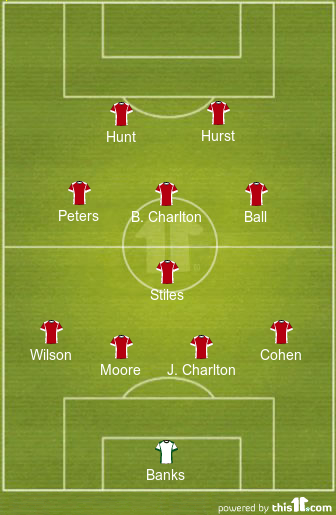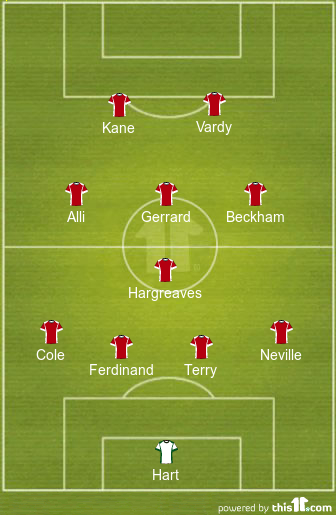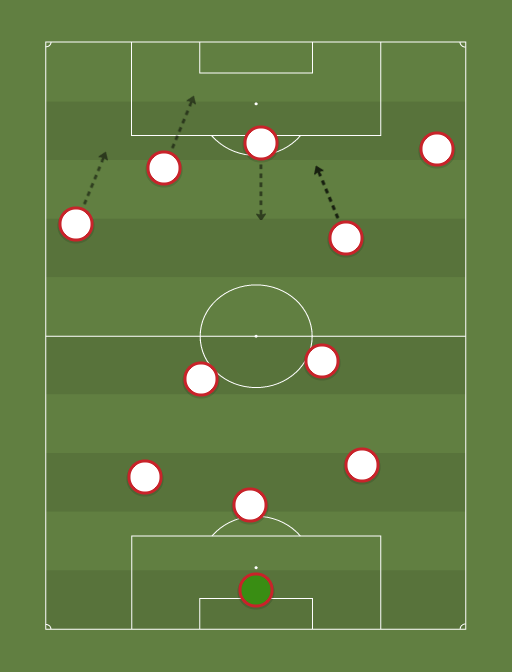Joga Bonito
The Art of Football
- Joined
- Jul 14, 2014
- Messages
- 8,270
Voters are asked to consider the XIs featured as remakes of classic teams, and to consider to what extent the manager has succeeded in re-creating both the individual roles and the overall functionality of the original. THIS IS NOT A FANTASY MATCH BETWEEN TWO SIDES, but rather a comparison of remakes.
Please feel free to tag the managers if you require more information about their set-ups/players etc.
Functional. Organised. Hard-working. They are the three key components of the 1966 World Cup team, and as a result they’re still seen today as critical components in the ideal English player. No fancy-dan #10s coasting about the field letting others do the work - the ideal is another Bobby Charlton, a truly complete player. That overarching philosophy exists right across the team.
There was nothing truly unique about this team - it was simply a collection of very capable individuals who were happy to sacrifice themselves for the team and create a whole better than the sum of its parts. That’s where England’s golden generation fell down, trying to fit in too many superstars and too many square pegs in round holes. Here we have the core of the golden generation with the addition of some selfless, tireless, multifunctional players to balance the team.
Style - Direct
Defense
Defensive Line - Normal
Marking - Man-marking
Off the ball - Aggressive closing down
On the ball - Build up Play/Rapid transitions through sweeper/Basic & risk-free passing to midfield etc
In the back four we have a unique proposition - a back four that knows each other’s games inside out and proved to be formidable against the toughest opponents. Jackie Charlton and Bobby Moore were your typical stopper-sweeper partnership and the foundation of that partnership was a telephathic understanding of where their partner is and how they would react in any situation. Wilson was one of the stalwarts in the team; very experienced and incredibly reliable. Cohen was the last to join that back four, integrating fully in the team just a year before the World Cup, but he slotted in seamlessly and was tasked with providing width in a team that played with no wingers.
Midfield
In midfield, we have a combination of steel, energy, intelligence and class, but above all else a level of cohesion that brings out the best of everyone’s distinct talents. Stiles was the typical destroyer, shuttting down everything that got in his way. Ahead of Stiles you had three players that all had fundamentally the same role - support the attack, support the defence, knit the play together. They were a trio of all-rounders.
Attack
In attack we have two tireless #9s - one excelling as a target man, the other as a constant threat in behind. Their role when the team's in possession is to stretch the opposition defence every which way, pulling out wide into the space or darting in behind at every opportunity. On the ball, their incessant running and defending from the front is critical in setting the tone for the team and forcing the opposition defence and midfield to concede possession easily.
Player Roles
In goal we have Joe Hart replacing the legendary Gordon Banks. Both play a significant role in the team through their personalities alone, and both capable of exceptional reaction saves and impossible saves 1-on-1. Fundamentally they are both exponents of a traditional goalkeeping style.
At left back we have Ashley Cole replacing Wilson, a man remembered by many as the first modern fullback. Whilst that may be a bit of English exaggeration - there were many before him - it is true that his role in the team was that of the modern fullback. Provide width on the flanks, support in attack at every opportunity and inject energy into the team. However a fullback’s #1 priority then was defence first. Ashley Cole fits that role perfectly. Cohen’s role was much the same on the opposing flank, with Gary Neville suitably stepping in to replace Cohen’s dangerous crosses. Rio Ferdinand is Bobby Moore’s only peer in English football, displaying the same combination of elegance, intelligence and immaculate timing. Jackie Charlton was your typical English bruiser; a brave, combative, tireless defender with real strength in the air. Terry slots into that role with ease.
Stiles was a warrior, a terrier, very quick across the ground and incessantly nibbling at people’s feet before playing the easy ball onto his more talented counterparts. Hargreaves fulfilled that role for club and country with aplomb, introducing himself to the world with a sterling man-marking job on Pablo Aimar in the 2000 UCL final, and re-introducing himself to the English public in 2006 as their player of the tournament.
Bobby Charlton was equally capable of being the matchwinner (vs. Portugal in the semi-final) or sacrificing himself for the team and man-marking the oppostion’s key player (vs. Beckenbauer in the final). He was the figurehead of the midfield and attack in one, an all-rounder with a responsibility to score the important goals in the important moments.
Ball was a tireless worker, and is remembered for his endless energy, but on top of that he was a very intelligent passer and very cleverly found space in a crowded midfield. He was a supporting player in every sense of the word, and in every phase of the game. Win the ball back, drive forward in possession, pick out a simple but incisive pass in attack. Beckham offers all that and more. While his pinpoint crosses took the limelight, it was his tireless workrate which provided the much needed balance in that United quartet. He spent much of his career telling people he wanted to play in the middle, and here he has the opportunity to do just that. On the occasions when he does drift out wide, he's more than capable of replicating Alan Ball's cross for Hurst's 2nd goal in the final many times over.
Peters was described by Sir Alf Ramsey as being a player ahead of his time. Intelligent, perceptive, creative, elegant and with plenty of skill. The essential element is that he was hard-working on top of that. He was also one of the youngsters in the team with just a few caps to his name, but by the time he’d finished his first game in the tournament he’d made it clear he was a critical component with his creative influence and goal threat. Dele Alli has been described as all of the same things over the past season. A precocious talent with a great combination of physique and technique with a tireless workrate.
Hunt is remembered by Liverpool fans as one of the superstars of the era and one of their heroes, a tremendous goalscorer. He’s remembered by England fans as an awkward workhorse who scored some important goals. George Hurst is remembered fundamentally the same way. Both players worked tirelessly for the time, defending from the front, pulling out wide and running in behind, fighting for every lost cause. Harry Kane and Jamie Vardy have displayed all of the same qualities throughout their careers with the goalscoring touch to match.
Please feel free to tag the managers if you require more information about their set-ups/players etc.
Team Brwned:
Philosophy/Ideology of tactical set-upFunctional. Organised. Hard-working. They are the three key components of the 1966 World Cup team, and as a result they’re still seen today as critical components in the ideal English player. No fancy-dan #10s coasting about the field letting others do the work - the ideal is another Bobby Charlton, a truly complete player. That overarching philosophy exists right across the team.
There was nothing truly unique about this team - it was simply a collection of very capable individuals who were happy to sacrifice themselves for the team and create a whole better than the sum of its parts. That’s where England’s golden generation fell down, trying to fit in too many superstars and too many square pegs in round holes. Here we have the core of the golden generation with the addition of some selfless, tireless, multifunctional players to balance the team.
Style - Direct
Defense
Defensive Line - Normal
Marking - Man-marking
Off the ball - Aggressive closing down
On the ball - Build up Play/Rapid transitions through sweeper/Basic & risk-free passing to midfield etc
In the back four we have a unique proposition - a back four that knows each other’s games inside out and proved to be formidable against the toughest opponents. Jackie Charlton and Bobby Moore were your typical stopper-sweeper partnership and the foundation of that partnership was a telephathic understanding of where their partner is and how they would react in any situation. Wilson was one of the stalwarts in the team; very experienced and incredibly reliable. Cohen was the last to join that back four, integrating fully in the team just a year before the World Cup, but he slotted in seamlessly and was tasked with providing width in a team that played with no wingers.
Midfield
In midfield, we have a combination of steel, energy, intelligence and class, but above all else a level of cohesion that brings out the best of everyone’s distinct talents. Stiles was the typical destroyer, shuttting down everything that got in his way. Ahead of Stiles you had three players that all had fundamentally the same role - support the attack, support the defence, knit the play together. They were a trio of all-rounders.
Attack
In attack we have two tireless #9s - one excelling as a target man, the other as a constant threat in behind. Their role when the team's in possession is to stretch the opposition defence every which way, pulling out wide into the space or darting in behind at every opportunity. On the ball, their incessant running and defending from the front is critical in setting the tone for the team and forcing the opposition defence and midfield to concede possession easily.
Player Roles
In goal we have Joe Hart replacing the legendary Gordon Banks. Both play a significant role in the team through their personalities alone, and both capable of exceptional reaction saves and impossible saves 1-on-1. Fundamentally they are both exponents of a traditional goalkeeping style.
At left back we have Ashley Cole replacing Wilson, a man remembered by many as the first modern fullback. Whilst that may be a bit of English exaggeration - there were many before him - it is true that his role in the team was that of the modern fullback. Provide width on the flanks, support in attack at every opportunity and inject energy into the team. However a fullback’s #1 priority then was defence first. Ashley Cole fits that role perfectly. Cohen’s role was much the same on the opposing flank, with Gary Neville suitably stepping in to replace Cohen’s dangerous crosses. Rio Ferdinand is Bobby Moore’s only peer in English football, displaying the same combination of elegance, intelligence and immaculate timing. Jackie Charlton was your typical English bruiser; a brave, combative, tireless defender with real strength in the air. Terry slots into that role with ease.
Stiles was a warrior, a terrier, very quick across the ground and incessantly nibbling at people’s feet before playing the easy ball onto his more talented counterparts. Hargreaves fulfilled that role for club and country with aplomb, introducing himself to the world with a sterling man-marking job on Pablo Aimar in the 2000 UCL final, and re-introducing himself to the English public in 2006 as their player of the tournament.
Bobby Charlton was equally capable of being the matchwinner (vs. Portugal in the semi-final) or sacrificing himself for the team and man-marking the oppostion’s key player (vs. Beckenbauer in the final). He was the figurehead of the midfield and attack in one, an all-rounder with a responsibility to score the important goals in the important moments.
Ball was a tireless worker, and is remembered for his endless energy, but on top of that he was a very intelligent passer and very cleverly found space in a crowded midfield. He was a supporting player in every sense of the word, and in every phase of the game. Win the ball back, drive forward in possession, pick out a simple but incisive pass in attack. Beckham offers all that and more. While his pinpoint crosses took the limelight, it was his tireless workrate which provided the much needed balance in that United quartet. He spent much of his career telling people he wanted to play in the middle, and here he has the opportunity to do just that. On the occasions when he does drift out wide, he's more than capable of replicating Alan Ball's cross for Hurst's 2nd goal in the final many times over.
Peters was described by Sir Alf Ramsey as being a player ahead of his time. Intelligent, perceptive, creative, elegant and with plenty of skill. The essential element is that he was hard-working on top of that. He was also one of the youngsters in the team with just a few caps to his name, but by the time he’d finished his first game in the tournament he’d made it clear he was a critical component with his creative influence and goal threat. Dele Alli has been described as all of the same things over the past season. A precocious talent with a great combination of physique and technique with a tireless workrate.
Hunt is remembered by Liverpool fans as one of the superstars of the era and one of their heroes, a tremendous goalscorer. He’s remembered by England fans as an awkward workhorse who scored some important goals. George Hurst is remembered fundamentally the same way. Both players worked tirelessly for the time, defending from the front, pulling out wide and running in behind, fighting for every lost cause. Harry Kane and Jamie Vardy have displayed all of the same qualities throughout their careers with the goalscoring touch to match.










